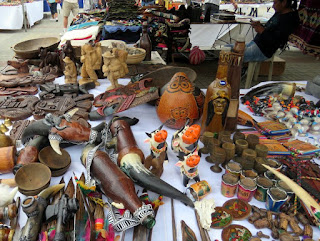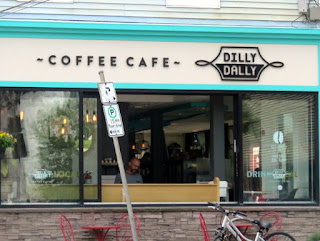 |
| M & J at the Veragua Rainforest reserve |
 |
| Passing through Limon, Costa Rica |
Beyond Key West, Sea Princess journeyed towards less prosperous countries, including Costa Rica, Panama, Ecuador, and Peru. The latter deserves a post to itself so that is for another day. We simply sailed through the Panama Canal, taking all day with commentary from "Hutch", the ship's destination director. We had traveled through the Canal in the reverse direction in 2014 on Cunard's Queen Victoria, and thought we would be using the new canal, still being built in 2014,
but it wasn't to be.
 |
| Houses are poor quality and public services lacking in many places. |
But first to Costa Rica, a politically stable but fairly poor country which straddles the America continent from coast to coast. This time, we berthed on the eastern or Atlantic side, at Limon. This side of the country has only two climates: wet and wetter. The Pacific Ocean region of the country has six months of dry season to complement the wet season and the more prosperous side. But Limon province is famous for its rainforest and has been developing a thriving eco-tourism and educational industry alongside its banana and coffee agricultural industries.
 |
| We reach the rainforest reserve eventually |
John had pre-booked an accessible excursion to the Veragua Rainforest Reserve through Princess Tours and I was on a wait-list, but later found no record. Upon enquiry, two days ahead of the scheduled arrival at Limon, the Tour office told me that the accessible coach had been canceled. I pointed out to the company that we had so little opportunity to access an excursion and that we were not the only passengers affected, so could they please do something for us!
 |
| Our top-class guide |
 |
| Diane and John, both from Sydney |
Anyway, I must have been persuasive, because the next morning they phoned and said they’d been able to “re-secure” the accessible coach. In the end, both Diane (also in a wheelchair and unable to stand) and John were able to use the coach’s electric hoist. There was only one space on the coach for a wheelchair user, however, and Diane had a fall, not hurting herself but getting a shock nevertheless, and had to be lifted into a seat by her husband Paul and the driver and her wheelchair stowed underneath. Luckily it was a manual chair. All of this was a hassle we could have done without.
 |
| Our ship is on the other side of these mountains |
 |
| Boarding the cable car in the Rainforest |
Altogether there were 30 passengers on this tour and we thoroughly enjoyed it, although the journey to the rainforest was exceedingly slow due to the state of the roads. It rained the whole way in the coach but fortunately stopped for the rest of the day upon our arrival 105 minutes later.
 |
| Sadly, just a toy sloth |
We expected to see monkeys and sloths, but if we saw a sloth, it was hardly recognisable, being so high in the trees. We certainly heard the howler monkeys though. They did screech, calling out to one another. The wildflowers were beautiful, many in the wild, more in a conservatory. There are also an abundance of frogs in the rainforest and they are a particular focus of local research, since some are endangered.
Upon returning to Limon city (in Limon province), we wandered the streets for a while. The gutter ramps were adequate, the shops busy but run-down and everything was covered with mildew because of the constant rain. The people were certainly friendly.
 |
| Panama Canal locks |
Returning to the ship, we had another sea day to experience before reaching the Panama Canal. Then it was a waiting game, with other ships also wanting to navigate the canal. Cruise ships are allowed through first, followed by freighters and then yachts and other commercial vessels.

The Panama Canal is far more interesting than the Suez, especially for the retired engineering and mechanical gurus amongst us. This is because of the differing levels of the two oceans, and the locks required to manage the difference.
 |
| The first Panama City |
At the far end of the Canal, I took a photo of the “real” Panama City, especially for the benefit of my cousins who live in the Florida city of the same name. Hello Shirley, Donna, Cheryl and Ben!
 |
| Market at Manta |
Manta, Ecuador was our next stop. This is a very poor country and it showed. The working dock is not within walking distance of the town so shuttle buses, including one with wheelchair access were provided.
 |
| Elaine and Vincenzo from Sydney |
Unfortunately, Sea Princess administrative arrangements did not work for John. All passengers wishing to use the shuttle buses were allocated a numbered ticket so we duly collected ours which were numbered 888 and 889. This required a long wait to be called to for a seat on the shuttle buses.
However, after waiting for 90 minutes in an allocated area, we were duly called, went to the secure exit at 11:30 am, and were told “Oh, sir, you’ll have to wait until 2:00pm to get off on the lower deck when the non-stepped ramp will be set up.” Both of us were livid to be told this, after waiting so long. The security team knew that the ramp would not be available, they knew in advance what the tides would be (or could have looked them up), and the management should have told us beforehand, rather than making us wait for a non-existent exit ramp. Not good enough. John was also worried about returning to the ship and was so disgusted with their lack of information and administrative arrangements that he decided against going out.
 |
| Hat-making in the market |
 |
| Ecuador is the home of panama hats, not Panama |
 |
| So much indigenous craft to choose from |
 |
| Manta port with the working dock in the distance |
I went out on my own, catching an ordinary shuttle bus to the market, but feeling disgruntled about our experience. I wandered along the fishing pier as well and took some photos on a grey day. But at least it wasn’t raining.
The Client Services staff, Tour Excursions staff and the Security team all work in silos – time and time again they cannot co-ordinate their processes to manage arrangements for passengers with mobility issues. An example is: “We’ll announce later when the mobility ramp will be available” and never do. We just find out by trial and error when we can disembark.
It is very tiring having to check and double check information, and often find it inconsistent.


































